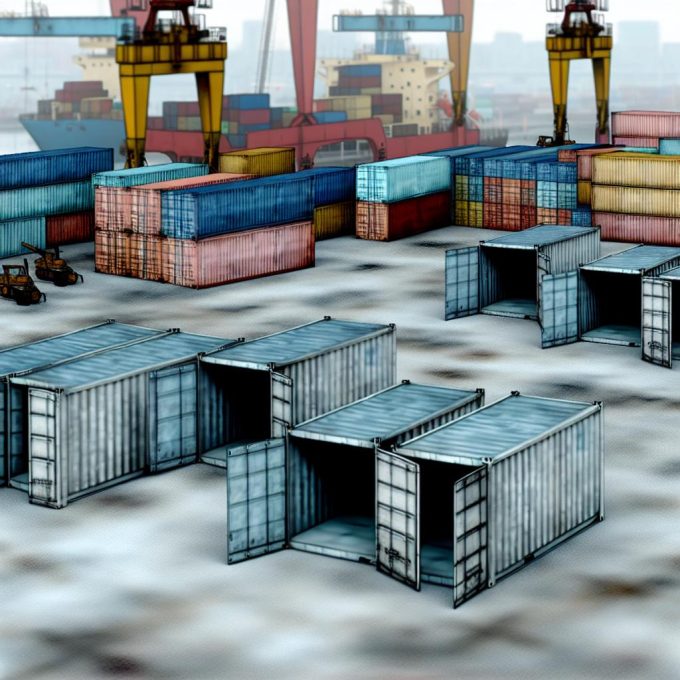Understanding Open-Top Containers
Open-top containers are a distinct type of shipping container designed to accommodate oversized cargo that cannot be easily loaded into standard closed containers. These containers have an open roof, typically covered by a tarpaulin instead of the standard steel and aluminum construction. The open-top design allows for loading and unloading of cargo from the top, which is ideal for tall or irregularly shaped items that exceed the height limitations of standard containers.
Structure and Design
The basic structure of an open-top container mirrors that of a conventional shipping container, maintaining the standard length and width dimensions. However, the notable difference is its open-top feature, covered with weatherproof tarpaulin to protect the cargo from environmental elements. The tarpaulin is fastened with ropes, ensuring it is secure during transportation. Some open-top containers have removable roof bows that provide additional structural support.
Open-top containers are generally constructed from corten steel which is known for its exceptional durability and weather-resistant properties. The steel frame provides the necessary strength to withstand the pressures of heavy loads, while the open roof design facilitates access for loading. Additionally, many open-top containers are equipped with lashing rings and anchoring points inside, enabling secure fastening of cargo during transit, which minimizes the risk of movement that could damage the goods or the container itself.
Loading and Unloading
Loading oversized cargo, such as heavy machinery or construction materials, into an open-top container typically requires the use of a crane or a similar lifting device. The absence of a fixed roof facilitates this vertical loading method. Once the cargo is in place, it is crucial to secure it adequately to prevent movement during transit, potentially causing damage. The securing process often involves bracing and blocking the cargo with materials such as wood or metal bars, and tying it down with straps or chains to the container’s internal lashing structures.
Unloading follows a similar process, but in reverse. The top-down approach allows for efficient unloading, especially if the receiving location has the necessary lifting equipment. The flexibility of loading from the top as opposed to the side also means that a broader range of pick-up and delivery environments can be accommodated, making open-top containers an adaptable choice for complex logistical needs.
Applications and Industries
Open-top containers are widely used across multiple industries, including construction, manufacturing, and logistics. They are particularly beneficial for transporting machinery, pipes, and other large equipment. Industries that deal with bulky goods often find open-top containers an indispensable part of their logistics strategy, ensuring efficient and safe transport of items that would be otherwise challenging to move.
For example, in the construction industry, these containers are essential for transporting large construction equipment and materials such as steel beams and precast concrete components. The oil and gas sector often utilize open-top containers to move drilling equipment and oversized industrial components. In manufacturing, items that are unusually shaped or exceed typical height limitations—such as parts of machinery, airplane parts, or gigantic molds—are commonly shipped in open-top containers.
Advantages and Considerations
One significant advantage of open-top containers is their versatility in accommodating a wide range of cargo types that exceed the height limits of standard containers. These containers provide flexibility to shippers in terms of accessible loading and unloading processes.
However, it is essential to consider the potential risks associated with exposure to environmental conditions and ensure that the tarpaulin and securing mechanisms are properly installed. The weatherproof tarpaulin protects the cargo from rain, wind, and other adverse weather conditions, but it is not as robust as the steel roofing found on standard containers. This requires shippers to ensure that the tarpaulin is securely fastened and inspected for any tears or weaknesses before transit.
Moreover, the security of the cargo is another critical consideration. Without the rigid top of a standard container, there is a greater need to ensure the cargo is securely lashed and prevented from shifting. This means considering the weight distribution of the cargo and using appropriate materials to brace the load efficiently.
Cost Implications
The cost of using open-top containers may vary based on size, destination, and additional handling requirements. Shippers should factor in these costs when strategizing their logistics plans. While open-top containers may be more expensive than standard containers due to their specialized nature, they offer a viable solution for transporting otherwise impossible loads.
The additional expense can often be justified by the savings and efficiencies gained in handling oversized cargo. Avoiding the need for disassembly of large equipment or choosing more costly alternatives like charter shipping can offset the higher upfront costs of open-top container shipping. Logistics planners must also consider customs regulations and tariffs which can vary, affecting the overall cost of shipping open-top containers internationally.
Conclusion
Open-top containers play a critical role in the transportation of oversized cargo. They offer specialized design features that make them invaluable for industries dealing with bulky or tall loads. Businesses must understand the logistical and financial considerations associated with open-top containers to effectively leverage their benefits for shipping oversized cargo.
Given their capabilities and versatility, open-top containers have carved out a niche that addresses specific shipping challenges. This means that when strategically deployed, they can translate into significant advantages for industries looking to optimize the movement of cumbersome goods—making them an essential component of modern shipping logistics. For further information, industry resources, and detailed guides on shipping oversized cargo, explore dedicated logistics and shipping platforms such as Maersk and CMA CGM.

